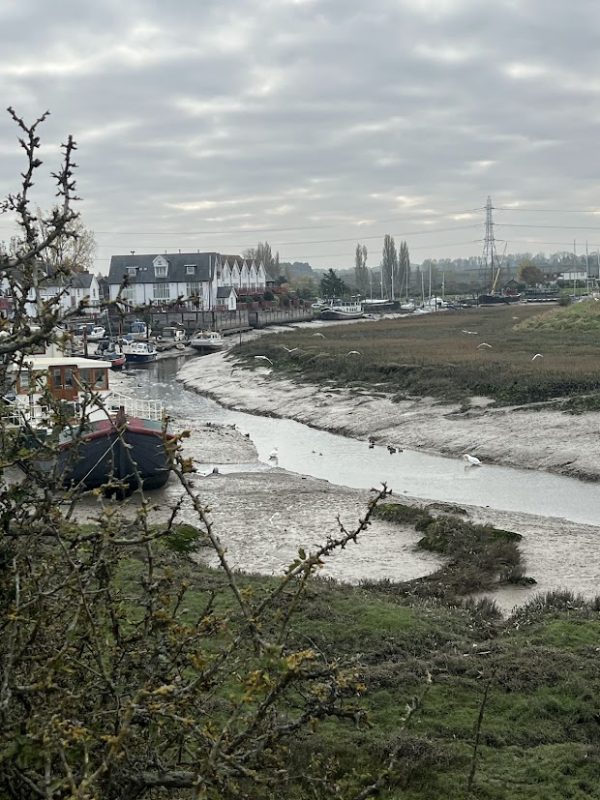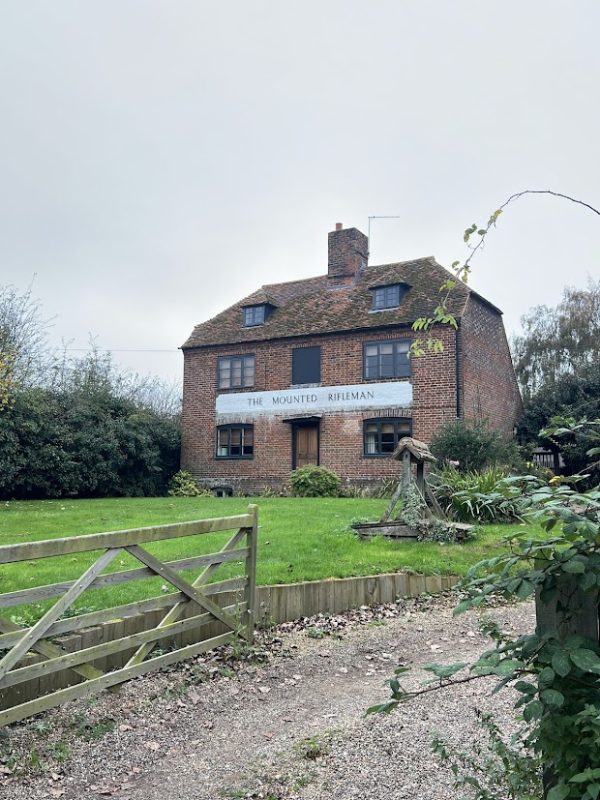Words Amicia de Moubray Photographs Posy Gentles, Amicia de Moubray
A couple of Sundays ago, I set out with my fellow Faversham Life writer Posy Gentles, to walk a circular route from Oare to Conyer to Luddenham and finally back to Oare – a total of 8.5 miles, although admittedly we did get lost a couple of times.

Maus, Amicia and Posy set off for a circular 8.5 mile walk from Oare
We set off from the Harty Ferry car park at Oare, looking across the Swale estuary to what was once the Isle of Harty but is now part of the Isle of Sheppey.
Edward Hasted, the great antiquarian and author of The History and Topographical Survey of the County of Kent 1778-99, describes Harty as being grazed by ‘4,000 sheep …. there is no village only six lookers cottages (small brick huts for shepherds) …. being the only inhabitants, the unhealthiness of the air deterring all others from attempting to dwell in it. By Hasted’s time, Harty had ceased to be a true island as the channel had silted up. The ferry, plying to and fro from Oare to Harty, ran until 1941 when it disintegrated and was never replaced.

Looking over to Harty on the Isle of Sheppey

The sublime estuarine landscape of North Kent
As we stepped out along the Saxon Shore way, we both marvelled at the beguilingly mysterious desolation of the Kentish estuarine landscape on a grey November morning. We mused that, despite being in one of the most crowded areas of England, we hardly encountered a soul in four hours. Our only companions were a flock of geese and a lone swan, not forgetting Maus, Posy’s diminutive poodle.

A sole swan

The new bridge from the mainland to the Isle of Sheppey
As we approached Conyer, the distant profile of the elegant new bridge (opened 2006) to Sheppey from the mainland emerged as if it was a mirage – reminiscent of the celebrated pictures of Waterloo Bridge by Monet currently on show at the Courtauld Institute.

Looking over to Conyer
We turned left down the tidal Conyer Creek to the little hamlet of Conyer. Today, it is a quiet hamlet tucked away from the A2 consisting of a few houseboats, The Ship Inn, a terrace or two of cottages and a couple of attractive New England style late 20th century housing developments. (The Ship has recently reopened after being closed for nine months).
But in the 19th century, it was pulsating with industry employing hundreds of people. There were seven large brick fields as well as cement making and barge building. It was ideally situated for transporting wares to London by boat. Earlier still, it was an epicentre of smuggling which was rife all along the Kent marshes.
Richardson’s cement works founded in 1850 with offices in Vauxhall and Paddington, comprised eight bottle kilns, a steam crane and a quay for barges. London stock bricks from Conyer were used to make the railway viaduct from London Bridge to Greenwich.
We rather lost our way here and, instead of continuing along the Swale Estuary Trail, took another footpath which fortuitously took us (via Teynham Court Farm, after which we turned left along the road for a few hundred yards before taking the signed footpath to the right) to the church of St Mary Teynham, before heading north to Teynham Street through a typical Kentish orchard.

A typical Kentish orchard

St Mary, Teynham

Reaching the road, we saw Banks Farmhouse, a typical 15th century Wealden hall house opposite and turned right along the road until we came to the very attractive Peete House. To the left of it, we continued along a footpath straight ahead, rather than veering left with the road.

Banks Farmhouse, an ancient hall house

Peete House
Hitting Teynham Street again, we turned right taking the Swale Heritage Trail to Deerton Street. We admired the natural burial ground before continuing along the Swale Heritage Trail, and turning left along a footpath until we hit the road again. Here we turned left and followed the road, passing the old Mounted Rifleman pub which closed some 20 years ago. It was notable for lacking a bar, the publican would descend into the cellar and reemerge with a tray of drinks. It has since been converted into a handsome house with four bedrooms. It is for sale as I write for £800,000.

The old Rifleman pub
We continued along the road for a while – not a single car passing us – until we reached the left turning on to a footpath leading to the 15th century Luddenham Court, whose venerable antiquity is masked by an 18thcentury façade. The farmhouse, its ancillary buildings and church of St Mary with its brick tower, make a pleasing ensemble conjuring up a potent vision of a vanished rural way of life. Like Conyer, this spot must have not so very long ago been a whirr of activity. Every Sunday the church would have been packed with local farm labourers, the farmer and his family as well as workers from the nearby water-powered gunpowder mill which operated from the early 18th century until 1934. Sadly, St Mary’s, redundant since 1972, was closed for ‘urgent maintenance work’. Nonetheless there are several fine gravestones to admire. There is a palpable feeling of being in a beguilingly remote spot looking out across the marshes, yet one is only a few minutes drive from Faversham.

A fine tombstone in Luddenham graveyard

St Mary, Luddenham
From here we diverged from the Swale Heritage trail and took the footpath north through Uplees, heading out across the marshes to rejoin the Saxon Shore Way and 10 minutes from the car parked at Harty Ferry.
On our walk, we passed a few more houses of architectural interest – notably the 16th century timber framed Crown House.
It is a very enjoyable walk – ideal for escaping from Christmas festivities.